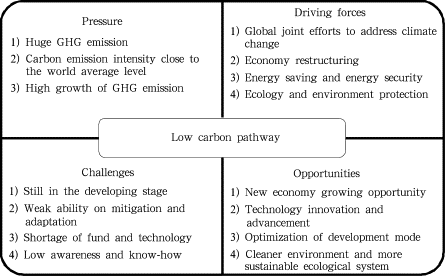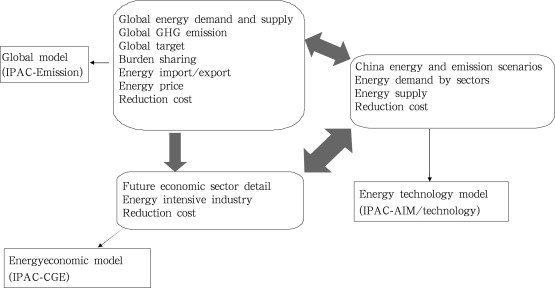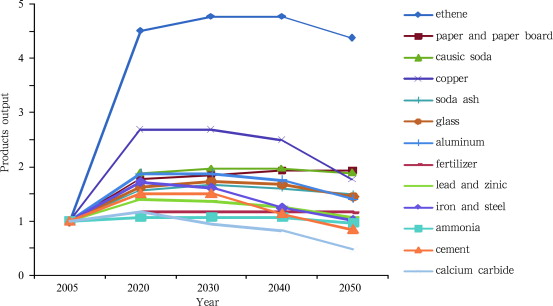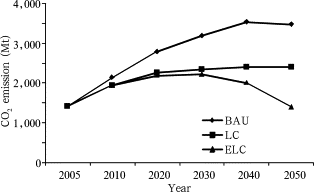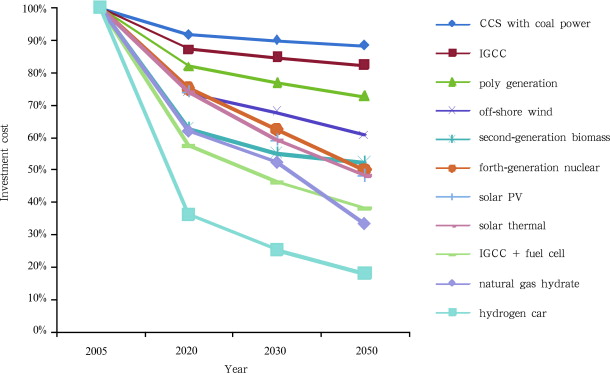m (Scipediacontent moved page Draft Content 379970415 to Liu et al 2015d) |
(→Abstract) |
||
| Line 1: | Line 1: | ||
==Abstract== | ==Abstract== | ||
| − | It is essential that China follows a low carbon pathway, in which technology plays a key role in the future economy and social development. Based on the Integrated Policy Assessment Model for China, this paper analyzes a technology development roadmap for China to achieve a low carbon scenario. The results show that there are plenty of potential and opportunities for China to move towards a low carbon society when given enhanced and accelerated applications and expansions of key low carbon technologies. Strong policy and measure supports from all sectors in China are needed to achieve this goal. | + | It is essential that China follows a low carbon pathway, in which technology plays a key role in the future economy and social development. Based on the Integrated Policy Assessment Model for China, this paper analyzes a technology development roadmap for China to achieve a low carbon scenario. The results show that there are plenty of potential and opportunities for China to move towards a low carbon society when given enhanced and accelerated applications and expansions of key low carbon technologies. Strong policy and measure supports from all sectors in China are needed to achieve this goal. |
| − | + | ||
| − | + | ||
| − | + | ||
| − | + | ||
==Keywords== | ==Keywords== | ||
Latest revision as of 13:59, 17 May 2017
Abstract
It is essential that China follows a low carbon pathway, in which technology plays a key role in the future economy and social development. Based on the Integrated Policy Assessment Model for China, this paper analyzes a technology development roadmap for China to achieve a low carbon scenario. The results show that there are plenty of potential and opportunities for China to move towards a low carbon society when given enhanced and accelerated applications and expansions of key low carbon technologies. Strong policy and measure supports from all sectors in China are needed to achieve this goal.
Keywords
climate change ; scenario ; low carbon ; technology ; roadmap
1. Introduction
Climate change, a global issue exerting heavy influences on the whole world, has been attracting more and more attentions because of its key role in sustainable development. The international community including developing countries is making unremitting efforts in this field, among these efforts greenhouse gas (GHG) emissions mitigation is crucial, in the sense to realize low carbon development mode and construct a sustainable development roadmap.
Low carbon development not only becomes a social economic development pathway for China’s future, but also facilitates China’s economic restructuring and accelerates the growth of industries with low energy consumption and high added-value. As pointed out, China will follow the strategic plan of enlarging the domestic demand and promoting economic growth, cultivate a new economic growth point featured by low carbon, and speed up the development of industry, construction and transportation with the characteristics of low carbon. To make progress in low carbon development, more efforts shall be made to mitigate GHG emissions in order to set up ways to reduce GHG emissions under current social, economic, technological and resource conditions. This work will undergo pressures and face challenges, but will also provide incentives and opportunities for people. It can be achieved only through the implementation of all kinds of policies and measures comprehensively (Fig. 1 ).
|
|
|
Figure 1. Four aspects of low carbon economy |
Though it is not in line with national conditions to reduce emissions in large scale, the combination of energy, agriculture and land use policies can lead to the slowdown of rocketing energy demand and GHG emissions, and can gradually complete the transformation of domestic economic development pattern.
Still in the mid of industrialization, China consumes a large amount of energy resources emitting pollutants and GHG while developing fast. The remarkable feature at this stage is the coexistence of advanced and backward technologies with the latter prevailing under the background of rapid expansion of economic scope. On the one hand, China has the advantage to completely eliminate out of date technologies and to employ international advanced technologies. On the other hand, it faces investment impulses in low-cost but backward in pursuit of scale expansion, which will lead to a “lock-in” of obsolete technologies, and will make the promotion of energy efficiency in China very difficult.
Therefore, in both short term and a long run, the prevailing of low carbon technologies is the key to promote GHG emission mitigation. Through stipulating feasible energy and environmental policies as well as technological development strategies, China can extensively transform its economy into low carbon type. Relevant domestic studies show that if appropriate policies are implemented, many advanced low carbon technologies have huge market potential and can gain popularity by 2020. Furthermore they will contribute to the fast economic development of China and the strong promotion of energy conservation and environmental protection, a win-win result.
This paper, in consideration of factors and driving forces behind future economic development, energy growth and emissions, analyzes the various technology portfolios under the different emission scenarios, and presents a key low carbon technology development roadmap for China.
2. Study method
While analyzing technique combinations and technology roadmaps, researchers at home and abroad usually adopt the scenario analysis methodology. They consider diversified factors including social economic development, energy resources, energy technologies, environment restrictions and consumption behavior, analyze different scenarios of energy and GHG emissions in future’s China, compare the difference of technique combination and contribution in various scenarios, and present technology roadmaps conducive to realizing low carbon economy [ Hu and Jiang, 2001 ; IEA, 2008 ;IPCC, 2007 ; Jiang and Hu, 2003 ; Jiang et al ., 2009 ; Liu et al ., 2009 ].
Based on the above method, the paper adopts Integrated Policy Assessment Model of China (IPAC) and uses the quantitative analysis method to study emission scenarios. Three sub-models of IPAC are mainly employed, namely IPAC-CGE, IPAC-Emission, and IPAC-AIM [ Hu and Jiang, 2001 ; Hu et al ., 1996 ]. The relationship among the three models can be viewed in Figure 2 . The three sub-models are connected through soft connection (i.e., outputs of one sub-model will be used as input in another sub-model. Results of the three models will be adjusted and get feedbacks from other sub-model, and this setup will lead to similar results coming from the three different models) to ensure the accuracy and rationality.
|
|
|
Figure 2. The model framework |
In model analysis, this paper first sets several key parameters. Based on the population scenarios by the National Population and Family Planning Commission, projection is made that China’s population will increase to peak value of 1.47 billion from 2030 to 2040 and decrease to 1.46 billion in 2050 [ NPDSRPT, 2007 ]. According to the three-step development plan of China, it is predicted that the development level of China in 2050, i.e., annual GDP increasing rate, will be about 6.4% from 2005 to 2050.
Parameters for the economic structure changes are based on outputs from IPAC-CGE, i.e., the proportion of secondary industry and the tertiary industry in macroeconomic aggregates will be 45.5% and 50.2% respectively in 2030, and 36.4% and 61.2% respectively in 2050. Furthermore, with correlation analysis and the judgments of industry experts, the yield changes of energy consuming industrial products are shown in Figure 3 . The changes in construction and transportation in terms of volume of services are studied in the same way. Using yield and serve volume as major inputs to IPAC-AIM/technology mode, the mode can produce low carbon technology compositions in various scenarios and therefore present a low carbon technology development roadmap for China.
|
|
|
Figure 3. The trend of output of main industry products (output is 1 in 2005) |
3. Scenarios
To produce a low carbon development roadmap of China, this paper designs three scenarios which will be compared in terms of technology composition to make a technology development roadmap.
(1) Business as usual (BAU). It presumes that China will take measures substantially influencing climate change such as policies concerning energy conservation and developing renewable, but will not take extra-efforts exclusive to fight climate change.
(2) Low carbon (LC). It reflects that in consideration of domestic social, economic and environmental demands, China will carry out national policies concerning climate change, and will take some measures as intensifying technology advance, transforming economic development modes, and changing consumption methods. It is a scenario with low energy consumption and low emission which can be achieved through domestic endeavors.
(3) Enhanced low carbon (ELC). It presumes that under the common prospect of global climate change mitigation, China will make its due contribution in emission reduction. On the one hand, this scenario considers the advanced technology enhanced across the world, the costs of major technologies dropping decreasingly, and the technology spreading increasingly from developed countries to developing counties. On the other hand, it takes into consideration that China as of 2030 will invest more in low carbon industries and technologies, boast a number of energy production and use the latest technologies (such as clean coal), which will help China stand in the top rank of the world in terms of technology development and application, and accomplish the popularity of carbon capture and storage (CCS) in the whole country.
According to our research and analysis, under similar social and economic development conditions, China will witness different trends in energy consumption and carbon emissions. This is mainly caused by differences in technology development and applications. Since this paper analyzes future low-carbon technology development guidelines, the comparison of carbon emission changes in different scenarios is the core.
Carbon emissions in different scenarios are compared① (Fig. 4 ). In the baseline scenario (BAU), China will go through a gradual increase in carbon emissions, reach peak around 2040 and arrive at plateau in 2050, when the increase of carbon emissions will slow down. In the LC scenario, though carbon emissions will keep climbing, its growth rate will be obviously lower than the BAU, and will land on plateau in 2030 and on, with a decrease of 30% in 2050 compared with the BAU. In the ELC scenario, the growth of carbon emissions will reach a turn, i.e., reach peak from 2020 to 2030 and then drop to the level of 2004 in 2050, 42% down compared with the LC scenario.
|
|
|
Figure 4. Energy-induced CO2 emission by 2050 in different scenarios |
4. Low carbon technology roadmap
The differences in the three scenarios above show that we have future potential in low carbon development. However, to reach the potential, we need to implement various policies and measures to reduce the investment costs in low carbon technologies and to increase its market shares and application scope. This is especially important for China, because the failure of applying and spreading low carbon technologies as early as possible will lead to the loss of opportunities of controlling and mitigating carbon emissions in the future.
In general, as market scope of low carbon technologies is enlarging, the investment and operation costs will gradually drop (this is also called learning effects of technologies), which will be conducive to the expansion of its market scope. Based on other relevant studies, we analyze several key cost learning curves (Fig. 5 ) and input the results into energy technology modes as important parameters in analyzing low carbon technology development roadmaps.
|
|
|
Figure 5. Unit investment cost② curves for key mitigation technologies (cost is 100% in 2005)③ |
Based on above analysis, this paper selects 14 crucial low carbon technologies, compares with the above scenarios, and produces the development roadmaps of those vital technologies under the targets of low carbon development (Fig. 6 , NGCC refers to natural gas combined cycle). In Figure 6 , red arrow represents technologies in the sprouting stage, brown arrow for technologies in the initial stage of marketing, green arrow for technologies in the marketing and popularity stage. After comparing the scenarios, we conclude that in contribution to the fulfillment of LC scenario in China, the 14 technologies in different time periods will exert diversified effects.
|
|
|
Figure 6. China low carbon technology development roadmap④ |
Before 2030, vital low carbon technologies in power sector, industry sector, building sector and transportation sector include off-shore wind power generation technologies, advanced industrial energy-use technologies, building integrated solar thermal/ heating technologies, hybrid vehicles, etc. After 2030, there will be other technologies exerting their due influences, among which CCS (including CCS in power sector and energy end use sectors) will make major contribution to the realization of ELC scenarios.
5. Conclusions and suggestion
Low carbon pathway in China means that the country or local regions will make best efforts to reduce GHG emissions, and will keep economy growing fast at relatively low reduction costs. Though China does not have the capacity and conditions to cut GHG emissions by large margin, we can still slow down the increase rate of GHG emissions and gradually transform to low carbon mode by adopting low carbon development mode.
The key to embark on the low carbon development pathway is to popularize low carbon technologies. This paper shows that to meet future low carbon development targets, in both energy production and energy consumption, technologies make their due contributions. Low carbon technologies concerning energy consumption will play a more significant role before 2030, and after 2030 low carbon technologies concerning energy production will play a larger role.
At present, energy conservation technologies reducing carbon emissions have the best marketing potential and economic benefits in China. Therefore, we shall take the opportunity as the country is making efforts on energy conservation and emission reduction and on the expansion of their applications in various sectors. In the industrial sector, energy conservation technologies should be spread through policies and measures when China is launching large scale infrastructure construction, to catch up the world level in terms of industrial energy efficiency in the period from 2020 to 2030. In the construction sector, energy efficient buildings should be popularized. In urban areas, targets for building energy efficiency shall be met; in rural areas, efforts should be made to construct more low cost and high energy efficient buildings, in order to reach the goal of increasing energy utilization efficiency by 30%–50% in 2030. In the transportation sector, endeavor to make public transportation become mainstream transport tool will be taken, hybrid vehicles become standard autos and electric vehicles comes to be more popular.
Clean energy technologies shall be encouraged through policy stimulus and the establishment and completeness of relevant markets. A number of clean energy technologies such as land wind generating technique with great potential are competitive in marketing. As long as adequate policy supports and healthy market environment are in place, those technologies will play their parts in the near future. Imports and expanding applications of some new technologies that already have stable market shares overseas, such as high efficient diesel autos, shall be taken into consideration. Encourages shall be made to scale up some off-grid renewable technologies by 2030, for instance, household renewable technologies (including solar thermal technologies, household PV technologies, household wind power technologies).
Because China will keep relying on fossil fuels such as coal, still be the biggest coal consumption country in the world, and occupy quite a large proportion in global coal consumption surge, more attentions shall be paid to clean coal technologies, especially clean coal generating technologies. Therefore, China shall establish comprehensive and effective national strategies to promote the development of clean coal and intensify international cooperation.
References
- Hu and Jiang, 2001 X. Hu, K. Jiang; GHG Mitigation Technology Option and Policy Assessment for China (in Chinese), Chinese Environment Science Publisher (2001), p. 252
- Hu et al., 1996 X. Hu, K. Jiang, J. Liu; Application of AIM/emission model in P. R. China and preliminary analysis on simulated results, AIM Interim Paper IP-96-02 (1996), p. 122
- IEA (International Energy Agency), 2008 IEA (International Energy Agency); Energy Technology Perspectives, OECD/IEA, Paris (2008), p. 650
- IPCC, 2007 IPCC; M. Bert (Ed.), et al. , Climate Change 2007: Mitigation. Contribution of Working Groups III to the Fourth Assessment Report of the Intergovernmental Panel on Climate Change, Cambridge University Press (2007), p. 851
- Jakobson, 2007 L. Jakobson; Innovation with Chinese Characteristic: High-Tech Research in China, Palgrave Macmillan (2007), p. 256
- Jiang and Hu, 2003 K. Jiang, X. Hu; GHG emission scenario assessment model for China and the World; D. Zhou (Ed.), China Energy Issue Research (in Chinese), Environmental Science Publishers (2003), pp. 238–251
- Jiang et al., 2009 K. Jiang, X. Hu, Q. Liu; 2050 China Energy and Carbon Emission Report (in Chinese), China Science Publishers (2009), p. 894
- Liu et al., 2009 Q. Liu, M. Shi, K. Jiang; New power generation technology options under the greenhouse gases mitigation scenario in China; Energy Policy, 37 (6) (2009), pp. 2440–2449
- NPDSRPT (National Population Development Strategy Research Project Team), 2007 NPDSRPT (National Population Development Strategy Research Project Team); National Population Development Strategy Report (in Chinese), China Population Publishers (2007), p. 3465
Notes
. Unit investment cost refers to static investment cost for installing unit technological equipment. For example, electricity cost is unit installation cost
. IGCC is the abbreviation of integrated gasification combined cycle, and PV is the abbreviation of photovoltaic
. CHCP is the abbreviation of combined heating, cooling and power, and NG is the abbreviation of natural gas
①. This paper only analyzes carbon emissions by fossil fuel combustion. It can still reflect the development trend of China’s total carbon emissions because they occupy the majority of the total carbon emissions in China
Document information
Published on 15/05/17
Submitted on 15/05/17
Licence: Other
Share this document
Keywords
claim authorship
Are you one of the authors of this document?
